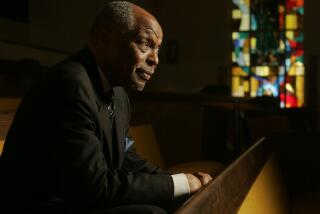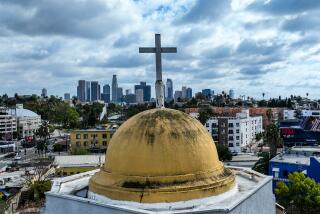The pastor and his sermons on the lot
- Share via
You never know where a churchman might find inspiration. For the Rev. Norman Hammer, it was a drive-in theater.
Hammer, then the 36-year-old pastor of Emmanuel Lutheran Church in North Hollywood, happened to pass an outdoor movie emporium one day in 1949 and was struck with the idea: Why not hold summer church services in such a setting? He figured it would be perfect for the balmy, open spaces of car-happy Southern California.
“A lot of people like to head for the beach or mountains on Sunday,” he explained later. “It’s hard to get them dressed up and into the church. This way, they come dressed for an outing and can leave for the out-of-doors right after the service.”
And, so, on July 10, 1949, long before anyone thought of “Honk If You Love Jesus” bumper stickers, Hammer convened what is believed to have been the first drive-in church service. He delivered a 45-minute sermon on a vacant lot across the street from 4-year-old Emmanuel Lutheran.
“Instead of piling out and filing into pews,” the Associated Press reported, arriving motorists and passengers “just settled back in their autos.”
“It was fun,” recalled Marty McCambridge, who attended in the 1960s with her parents in the family’s green Nash Rambler. “You could wear your play clothes. You could talk. You could sing as loud as you wanted — it didn’t matter if you could sing or not.”
There were lots of smiles on the faces of children who were dreaming of their next destination.
“Usually we were going to go to Disneyland or Knott’s,” McCambridge said.
A friend of hers used to go to the outdoor service in his Little League uniform.
As the years went by Hammer would be overshadowed by the more-charismatic Rev. Robert Schuller, who began preaching at the old Orange Drive-In in 1955.
But the drive-in church service was Hammer’s innovation. And he had one obstacle that Schuller did not face: no built-in sound system.
The first year, Hammer recalled, he took care of the problem by procuring “three speakers from a Navy boat and a 50-watt amplifier.”
The next year, he learned that the San Val Drive-In in Burbank was installing new speakers and persuaded the theater to let him have the old ones at $3 apiece (they were $9 new).
“We hereby swear that they (the speakers) will never be used in any way whatsoever for entertainment purposes,” the church wrote to the drive-in, which apparently was nervous that it might be gaining a competitor.
Worshiping motorists didn’t have to pass the plate — at least not literally. Ushers went from car to car for offerings, each carrying a cigar-box-on-a-stick with a slot for cash on top. The standard collection plate couldn’t be used because the wind would sometimes blow the paper currency onto the ground.
The outdoor service was an immediate hit, drawing an average of about 175 people and 90 cars per Sunday (though not so many that anyone can ever recall the church being the site of a SigAlert).
The cigar boxes filled up. That July of 1949, Hammer wrote, “we had our biggest month financially.”
“I was amazed to see all the people sitting in their cars,” said Fred Bernlohr, who was pastor from 1966 to 1972.
Despite Emmanuel Lutheran’s success, outdoor church services never really caught on around the country.
A few can still be found in cities such as Daytona, Fla.; Grand Rapids, Mich.’ and Albany, N.Y.
Schuller, of course, long ago moved his pulpit from the roof of the snack bar at the Orange Drive-In to his church in Garden Grove, where services are now held in the Crystal Cathedral. The cathedral recently filed for bankruptcy, citing more than $43 million in debts. It costs a lot more to run than the Orange Drive-In, which Schuller rented for $500.
Emmanuel outdoor services came to an end in the early 1970s: the Valley’s wide-open spaces were no longer so open. The church needed the vacant lot where the motorists prayed for a football/soccer field for its Laurel Hall School.
“Before, it was just dirt,” said McCambridge, a longtime congregant who is now the parish office manager. “Now it’s a real field with grass. You couldn’t drive on it.”
The era has also passed when congregants felt they couldn’t wear the same clothes to both church and Disneyland.
“That was when people still dressed up for church,” McCambridge noted.
Bernlohr, the 88-year-old former pastor, has fond memories of sermonizing outdoors at Emmanuel.
The drivers and their passengers “did listen, which surprised me,” he said. “I don’t recall anyone reading the morning paper.”
And he did get feedback. Once in a while, he said, someone would thank him at the end of a service by honking.
More to Read
Sign up for Essential California
The most important California stories and recommendations in your inbox every morning.
You may occasionally receive promotional content from the Los Angeles Times.










